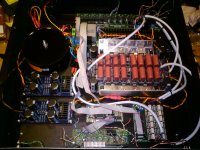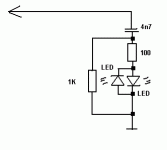I hope you wise people can give me some pointers on the following issue:
Me and a friend are finishing up our Aleph P 1.7 build. We used Kristian's boards and input selector / volume control from Dantimax.
As a source I'm using 2V out (balanced) from IVYIII (Buffalo II DAC). When using balanced signal and no input attenuation (selector switches), the sound is extremely distorted (high frequency). When using single ended inputs or attenuation on the input (switches all open (10k on the input)), the distortion disappears.
Any ideas on what could cause this distortion?
I read in some other post that this could be due to oscillation and this could be solved by changing the gate resistors on the 610's of the input from 221ohm to 1k?
Or could a too low input impedance on the Aleph P make the IVYIII go haywire?
Any other suggestions?
Me and a friend are finishing up our Aleph P 1.7 build. We used Kristian's boards and input selector / volume control from Dantimax.
As a source I'm using 2V out (balanced) from IVYIII (Buffalo II DAC). When using balanced signal and no input attenuation (selector switches), the sound is extremely distorted (high frequency). When using single ended inputs or attenuation on the input (switches all open (10k on the input)), the distortion disappears.
Any ideas on what could cause this distortion?
I read in some other post that this could be due to oscillation and this could be solved by changing the gate resistors on the 610's of the input from 221ohm to 1k?
Or could a too low input impedance on the Aleph P make the IVYIII go haywire?
Any other suggestions?
how is your gain set? by R36.
Currently at 1k..
Nice layout. Ours is still a bit of a spiderweb  .
.
Maybe I wasn't totally clear in my inititial description:
-volume control is on the output
-when the switches on the input side are all open (so the 10k resistors in series with the input are in use (R5 & R6 in the Aleph service manual)), there is no distortion, even with balanced input
-when the switches 1&2 (switches 2&4 in Kristian's manual) are closed (input bypasses 10k resistor and goes directly to the input cap), then there is distortion (and quite a lot of it).
I was under the impression that with a normal input signal (consumer level, 2V), you shouldn't get any distortion, regardless of the setting of the switches at the input. I however do not know if this assumption is correct, regardless of the input source. Or that there's something with the layout of Kristian's board which makes them behave differently. Or something in the grounding. Or if this is dependent on the source.
I will have a look and see if increasing the gain resistor (decreasing the gain), results in less distortion.
Maybe I wasn't totally clear in my inititial description:
-volume control is on the output
-when the switches on the input side are all open (so the 10k resistors in series with the input are in use (R5 & R6 in the Aleph service manual)), there is no distortion, even with balanced input
-when the switches 1&2 (switches 2&4 in Kristian's manual) are closed (input bypasses 10k resistor and goes directly to the input cap), then there is distortion (and quite a lot of it).
I was under the impression that with a normal input signal (consumer level, 2V), you shouldn't get any distortion, regardless of the setting of the switches at the input. I however do not know if this assumption is correct, regardless of the input source. Or that there's something with the layout of Kristian's board which makes them behave differently. Or something in the grounding. Or if this is dependent on the source.
I will have a look and see if increasing the gain resistor (decreasing the gain), results in less distortion.
Nice layout. Ours is still a bit of a spiderweb.
Maybe I wasn't totally clear in my inititial description:
-volume control is on the output
-when the switches on the input side are all open (so the 10k resistors in series with the input are in use (R5 & R6 in the Aleph service manual)), there is no distortion, even with balanced input
-when the switches 1&2 (switches 2&4 in Kristian's manual) are closed (input bypasses 10k resistor and goes directly to the input cap), then there is distortion (and quite a lot of it).
I was under the impression that with a normal input signal (consumer level, 2V), you shouldn't get any distortion, regardless of the setting of the switches at the input. I however do not know if this assumption is correct, regardless of the input source. Or that there's something with the layout of Kristian's board which makes them behave differently. Or something in the grounding. Or if this is dependent on the source.
I will have a look and see if increasing the gain resistor (decreasing the gain), results in less distortion.
i just have the inputs switches open. use a 1-2Kohm stereopot insted of R36 if you need to adjust the gain.
yes, my amp is not finnished yet
I was under the impression that with a normal input signal (consumer level, 2V), you shouldn't get any distortion, regardless of the setting of the switches at the input. I however do not know if this assumption is correct, regardless of the input source.
I will have a look and see if increasing the gain resistor (decreasing the gain), results in less distortion.
With a scope take a look at the output signal at the drain of Q18. You may find that the peak to peak voltage is very high and the preamp is essentially clipping.
I've never run my version of the P1.7 balanced so I don't know if there are any special considerations.
Jeremy
With a scope
And now for a scope...
I indeed came to the conclusion that if I want a definitive answer on oscillation or clipping for that matter...I would need an oscilloscope, which I don't have. Maybe invest in a second hand.
Would something in the 20Mhz region suffice or do I really need 100Mhz or more for these kinds of analysis (including checking oscillation (also on opamps)?
@AudioSan
can you give some details about the caps you used in your setup? I also want to use these boards, but I can`t find caps which will fit in pcb and are really good. to know where to buy will be good too ;-)
greetings Arno
Hi Arno,
I am not AudioSan...
my experience
Elna Silmic 50V/220uF bypassed by 100nF, that is the setup I returned to, after trying Obbligato, Blackgate, Erol, Cornel Dublier.... every cap had its own advantages, but overall I preferred the Silmics.....
@AudioSan
can you give some details about the caps you used in your setup? I also want to use these boards, but I can`t find caps which will fit in pcb and are really good. to know where to buy will be good too ;-)
greetings Arno
what caps? the red ones? they are panasonic. i got them from mouser.
10uF 250V i think. its a long time ago
Well, thank you all for your input.
Unfortunately I was listening last night on the single ended inputs and after about 3 hours listening time the distortion appeared sometimes (even with the 10k resistors on the input).
It sounds like the sound is transformed into high frequency static. The 9610's also get quite hot (they are on small heatsinks). So this seems like oscillation from what I have read so far...
There are 680pF capacitors between the collector and emitter of the ZTX550's. Would adding 1nF capacitors between the base and collector as described here be a possible solution?:
http://www.diyaudio.com/forums/pass-labs/114680-preamplifier-pass-x2-0-1-a-9.html
Or should I be buying a scope (which isn't a bad idea anyway) and do a more thorough analysis before I start adding components?
Unfortunately I was listening last night on the single ended inputs and after about 3 hours listening time the distortion appeared sometimes (even with the 10k resistors on the input).
It sounds like the sound is transformed into high frequency static. The 9610's also get quite hot (they are on small heatsinks). So this seems like oscillation from what I have read so far...
There are 680pF capacitors between the collector and emitter of the ZTX550's. Would adding 1nF capacitors between the base and collector as described here be a possible solution?:
http://www.diyaudio.com/forums/pass-labs/114680-preamplifier-pass-x2-0-1-a-9.html
Or should I be buying a scope (which isn't a bad idea anyway) and do a more thorough analysis before I start adding components?
- Status
- This old topic is closed. If you want to reopen this topic, contact a moderator using the "Report Post" button.
- Home
- Amplifiers
- Pass Labs
- Aleph P 1.7 - distortion


